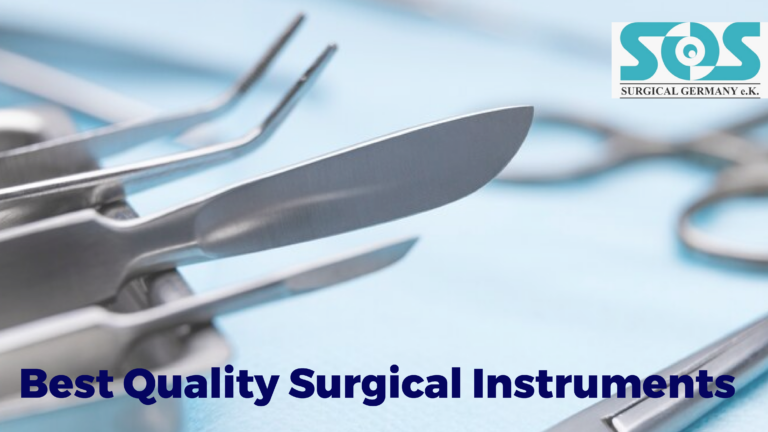Surgical instruments are vital tools in the medical field, playing a critical role in the success of surgical procedures. Whether you are setting up a new medical facility, upgrading your current inventory, or simply replenishing supplies, purchasing high-quality surgical instruments is paramount. This guide provides a comprehensive overview of how to buy surgical instruments, covering essential aspects such as understanding different types of instruments, evaluating quality, selecting reliable suppliers, and ensuring proper maintenance.
Understanding Surgical Instruments
Types of Surgical Instruments
Surgical instruments are classified based on their function. Here are the primary categories:
Cutting and Dissecting Instruments: These include scalpels, scissors, and bone saws. They are designed to cut through skin, tissue, and bone.
Grasping and Holding Instruments: Instruments such as forceps, clamps, and needle holders fall into this category. They are used to hold or manipulate tissues.
Hemostatic Instruments: Hemostats and other similar tools are used to control bleeding during surgery by clamping blood vessels.
Retracting Instruments: Retractors are used to hold back tissues or organs to provide surgeons with a clear view of the surgical site.
Suturing Instruments: Needle holders and various types of sutures are essential for closing wounds or surgical incisions.
Electrosurgical Instruments: These instruments use electrical currents to cut tissue or coagulate blood, offering precision and minimizing bleeding.
Material Considerations
The material of surgical instruments significantly impacts their performance, durability, and cost. Common materials include:
Stainless Steel: Known for its durability and resistance to corrosion, stainless steel is the most commonly used material for surgical instruments. It offers longevity and reliability.
Titanium: Lighter than stainless steel and highly resistant to corrosion, titanium instruments are often used in delicate surgeries. They are more expensive but offer superior performance.
High-Grade Plastics: Used in disposable instruments, high-grade plastics provide a cost-effective option for single-use applications, ensuring sterility and convenience.
Quality and Standards
When purchasing surgical instruments, it is crucial to ensure they meet international quality standards and certifications. Key standards include:
ISO 13485: This certification specifies requirements for a quality management system specific to medical devices.
CE Marking: Indicates conformity with health, safety, and environmental protection standards for products sold within the European Economic Area.
FDA Approval: In the United States, the Food and Drug Administration (FDA) regulates medical devices, including surgical instruments, ensuring they meet stringent safety and efficacy standards.
Factors to Consider When Buying Surgical Instruments
Supplier Reputation
Choosing a reputable supplier is critical. Look for suppliers with a proven track record, positive reviews, and necessary certifications. A good supplier should also offer warranties and comprehensive after-sales support.
Cost vs. Quality
While budget constraints are a reality, prioritizing quality over cost is essential. High-quality instruments may be more expensive initially but tend to last longer, perform better, and reduce the risk of surgical complications. Investing in quality ensures better outcomes and long-term savings.
Customization and Range
A good supplier should offer a wide range of instruments and customization options to meet specific surgical needs. Customization might include modifications in size, shape, or material to better suit the surgeon’s preferences or the surgical technique.
Sterilization and Maintenance
Consider the ease of sterilization and maintenance of the instruments. Instruments that are easy to clean and sterilize reduce the risk of infection and prolong the instrument’s life. Some instruments may come with specialized coatings that enhance their resistance to wear and corrosion.
Steps to Buying Surgical Instruments
Needs Assessment
Start by conducting a thorough needs assessment. Understand the types of surgeries your facility performs and the specific instruments required. Consult with surgeons and other healthcare professionals to create a detailed list of needed instruments.
Research and Shortlist Suppliers
Research potential suppliers, considering their reputation, range of products, and customer reviews. Shortlist suppliers who meet your criteria and request detailed catalogs or product lists.
Evaluate Samples
Before making a large purchase, evaluate samples from shortlisted suppliers. Assess the quality, weight, balance, and usability of the instruments. Involve the end-users in this evaluation to gather practical feedback.
Check Certifications
Verify that the instruments meet necessary regulatory standards and certifications. This step ensures compliance with legal and safety requirements and guarantees the instruments’ quality.
Negotiate Terms
Negotiate terms with your chosen supplier, focusing on price, delivery schedules, warranty, and after-sales support. Consider entering into a long-term contract for better terms and consistent supply.
Finalize Purchase
After successful negotiation, finalize the purchase. Ensure all agreements are documented, including delivery timelines, payment terms, and any warranties or guarantees.
Training and Implementation
Once the instruments arrive, ensure that all relevant staff are trained on their proper use, sterilization, and maintenance. Proper training minimizes the risk of misuse and extends the instruments’ lifespan.
Conclusion
Buying surgical instruments is a complex but critical process that demands careful consideration and diligence. By understanding the types of instruments, prioritizing quality, and following a structured purchasing process, healthcare facilities can ensure they are equipped with the best tools for their surgical needs. Embracing future trends and maintaining rigorous standards for maintenance and management will further enhance the effectiveness and longevity of these essential instruments. With the right approach, you can make informed decisions that not only meet immediate surgical needs but also contribute to overall patient safety and successful surgical outcomes.

